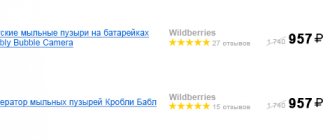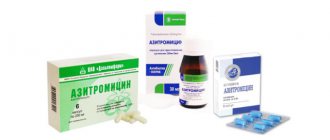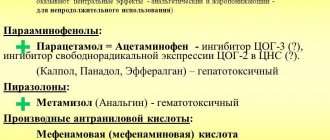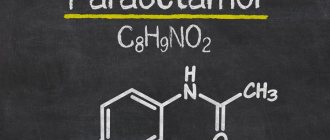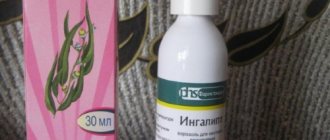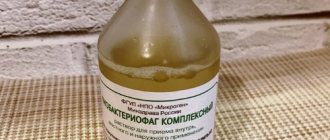Mechanism of action of Panadol
Cyclooxygenase is an enzyme present in nerve cells that is responsible for the production of prostaglandin. Paracetamol, which is present in Panadol, affects this enzyme, inhibiting it. As a result of this, the components of the medicine affect the temperature regulation center, thereby normalizing the temperature and eliminating pain.
Comparing other medications with similar actions as Panadol, it does not have an anti-inflammatory effect. Panadol does not affect the process of prostaglandin synthesis, which is noted in peripheral tissue cells. This is explained by the absence of side effects of the drug on the digestive tract system.
How long after taking does it take effect?
It is worth noting that Panadol in the form of a suspension is absorbed by the body much faster than in suppositories.
The difference in the effect of different forms of medicine in the body is as follows. How long does it take for Panadol to work in various forms?
| Suspension | Candles |
| The suspension dose contains paracetamol in an amount of 120 mg/5 ml. Absorption begins 20 minutes after taking the drug. The duration of the effect is 2 hours. | One suppository contains paracetamol in the amount of 125 mg/250 mg. Absorption begins 90-120 minutes after administration. The duration of the effect is 6 hours. |
Release form and composition
Children's Panadol in the form of a suspension looks like a viscous syrupy liquid, which is why this medicine is often called syrup. The solution has a pink tint and a strawberry aroma, and the drug tastes sweet.
The volume of medication in one glass bottle is 100 ml or 300 ml. The bottle is sold together with a plastic syringe and instructions.
The main component of the drug that provides Children's Panadol with its therapeutic effect is paracetamol. Its amount in 5 milliliters of solution is 120 mg.
For a liquid and viscous consistency, as well as to prevent spoilage, the medicine contains esters of parahydroxybenzoic acid, sorbitol, xanthan gum, water, citric and malic acid.
The medicine for internal use has a viscous consistency, pink in color with a strawberry aroma. 5 ml of the product contains about 120 mg of paracetamol. Additional components are:
- Water;
- Sorbitol;
- malic and citric acid;
- Maltitol;
- Azorubine;
- xanthan gum;
- sodium nipasept.
The instructions for panadol baby indicate that the product should be produced in bottles of 100 or 300 ml. The cardboard boxes come with a measuring syringe.
When to give it to children?
As soon as parents notice that the child’s condition has worsened, as evidenced by general lethargy, malaise, insomnia, cough, runny nose, diarrhea and other symptoms that are not normal, they should resort to antipyretics. However, Panadol is most often used at elevated temperatures, which are caused by:
- flu;
- measles;
- chicken pox;
- mumps;
- ARVI;
- rubella;
- intestinal infectious disease;
- the body's reaction to the vaccine.
The value of a child’s specific temperature cannot be given in general terms here, because everything depends on a number of factors. Let us only note that, as a rule, with normal health, absence of chronic diseases and signs of dehydration, the temperature of children under one year old begins to be lowered from 38℃, and over one year old - 38.5℃.
Interaction with other drugs
The simultaneous use of panadol extra soluble tablets with butadione, rifampicin, and anticonvulsants increases the risk of hepatotoxicity. During treatment with paracetamol, the anticoagulant effect is enhanced when combined with coumarin derivatives.
It is possible that the toxicity of chloramphenicol may increase when used with this medicine. The combination of paracetamol with ethinyl estradiol leads to increased absorption of the former, but cholestyramine and probenecid have the opposite effect. Even with a slight overdose, severe intoxication of the body is possible with an increase in the production of hydroxylated metabolites. This effect is due to additional intake of tricyclic antidepressants, hepatotoxic medications, and barbiturates.
Some parents decide to use local anesthetics in the form of an ointment or gel that is applied to the gums. They are freely available at the pharmacy, but here, as in any other matter, it is important not to overdo it.
The pharmacy also offers homeopathic drops and suppositories to alleviate the condition.
What exactly to use is up to you and your doctor to decide. Below we will look at the tools available in the arsenal today, as well as their pros and cons.
Before giving Children's Panadol for fever or pain, it is important to clarify whether the child is taking any other medications, because paracetamol preparations should not be combined with many other medications. A complete list of them is available in the annotation for the suspension.
At what age is it given?
The suspension is recommended for use as an antipyretic drug that normalizes temperature and reduces pain for children aged 3 months to 12 years. Panadol is not prescribed to babies under three months of age, although in practice there are exceptional cases when the medicine was prescribed at the age of 1 month to reduce the temperature raised as a result of vaccination. However, such a situation is exceptional, so taking Panadol to a one-month-old baby should be a one-time use and strictly supervised by a doctor.
Dosage
Up to 6 months, suppositories are not prescribed, although the rectal form containing 125 mg of paracetamol is indicated for patients aged 6 to 30 months. A more serious dosage of 250 mg is prescribed for children from 3 to 6 years old.
For children over 12 years of age, Panadol is prescribed in tablet form, 500 mg, which is much more convenient to take.
It is worth noting that candles have some weight restrictions. A child weighing 8-12 kg is prescribed a drug containing 125 mg of the active substance; patients weighing 13 kg or more will be prescribed suppositories with a dosage of 250 mg.
Contraindications
However, Panadol is not recommended for all children. There are some restrictions on the use of this medicine that apply to children:
- having individual intolerance to the components of the drug;
- who have been diagnosed with kidney problems;
- diagnosed with anemia;
- having liver disease;
- lacking glucose-6-phosphate dehydrogenase in the body at the genetic level.
Indications for use
Most often, Panadol Baby is given to children with fever, which can be caused by:
- flu;
- chicken pox;
- scarlet fever;
- measles;
- ARVI;
- rubella;
- intestinal infection;
- mumps;
- vaccination and other reasons.
Since the drug also has an analgesic effect, this Panadol can also be used for pain, for example:
- due to teething;
- with otitis;
- for throat diseases;
- for bruises, fractures and other injuries.
The suspension is not prescribed if the child has:
- intolerance to paracetamol or any of the auxiliary components of the solution has been identified;
- there are disturbances in the functioning of the kidneys;
- have liver problems;
- a genetically determined absence of glucose-6 phosphate dehydrogenase has been detected or there is fructose intolerance;
- have severe blood diseases, such as anemia or thrombocytopenia.
The drug Panadol, according to the instructions, is prescribed for children from 3 months to 12 years. Main indications of Panadol:
- toothache, headache, earache and sore throat. If these symptoms are associated with otitis media, teething, etc.;
- elevated body temperature. The suspension is taken if fever occurs against the background of the development of infectious and colds.
The instructions for children's Panadol are not indicated, but after vaccination in infants, a single dose of medication is possible to lower the temperature.
All forms of Panadol are contraindicated in children who have been diagnosed with:
- intolerance to the composition of the drug;
- severe kidney and liver dysfunction
Candles are not allowed if diagnosed
- blood pathologies;
- congenital deficiency of glucose-6-phosphate dehydrogenase;
- inflammation of the rectum;
- bleeding from the anus.
The suspension is prohibited for children with intolerance to fruit sugar.
With caution, the drug, regardless of the form of release, should be used in cases of mild to moderate impairment of liver and kidney function.
By-effect
Despite the overwhelming number of patients who took the medicine and did not experience any side effects, the manufacturer warns about possible side effects when taking Panadol:
- an allergic reaction in the form of skin rashes, itching, redness, swelling and even anaphylactic shock;
- disorders of the gastrointestinal tract and liver;
- spasmodic reaction of the bronchi;
- Long-term use of the drug can affect the production of blood cells, thereby allowing their number in the body to decrease.
Synonyms of nosological groups
| Category ICD-10 | Synonyms of diseases according to ICD-10 |
| H66 Suppurative and unspecified otitis media | Bacterial ear infections |
| Inflammation of the middle ear | |
| ENT infections | |
| Infectious and inflammatory disease of ENT organs | |
| Infectious and inflammatory diseases of the ENT organs | |
| Infectious and inflammatory diseases of the ear | |
| Infectious diseases of the ENT organs with severe pain syndrome | |
| Ear infection | |
| Infectious otitis media | |
| Persistent inflammation of the middle ear in children | |
| Ear pain due to otitis media | |
| J03.9 Acute tonsillitis, unspecified (angina agranulocytic) | Angina |
| Sore throat, alimentary-hemorrhagic | |
| Sore throat secondary | |
| Primary tonsillitis | |
| Sore throat follicular | |
| Sore throats | |
| Bacterial tonsillitis | |
| Inflammatory diseases of the tonsils | |
| Throat infections | |
| Catarrhal sore throat | |
| Lacunar tonsillitis | |
| Acute sore throat | |
| Acute tonsillitis | |
| Tonsillitis | |
| Acute tonsillitis | |
| Tonsillar tonsillitis | |
| Follicular tonsillitis | |
| Follicular tonsillitis | |
| K13.7 Other and unspecified lesions of the oral mucosa | Aspirin burn of the oral mucosa |
| Sore gums when wearing dentures | |
| Oral inflammation | |
| Inflammation of the oral mucosa | |
| Inflammation of the oral mucosa after radiation therapy | |
| Inflammation of the oral mucosa after chemotherapy | |
| Inflammation of the oral mucosa | |
| Inflammation of the mucous membranes of the oral cavity | |
| Inflammatory diseases of the oral cavity | |
| Inflammatory process of the pharynx | |
| Disease of the oral mucosa | |
| Radioepithelitis | |
| Irritation from dentures | |
| Irritation of the oral mucosa by dentures and braces | |
| Oral wounds | |
| Sores from wearing dentures | |
| Injuries to the oral cavity and larynx | |
| Injuries to the oral mucosa | |
| Trophic diseases of the oral mucosa | |
| Trophic diseases of the oral mucosa | |
| Erosive and ulcerative periodontal lesions | |
| Erosive and ulcerative lesions of the oral mucosa | |
| Erosive and ulcerative periodontal lesions | |
| Erosive and ulcerative lesions of the oral mucosa | |
| Erosion of the oral mucosa | |
| R50 Fever of unknown origin | Hyperthermia malignant |
| Malignant hyperthermia | |
| R51 Headache | Head pain |
| Pain due to sinusitis | |
| Pain in the back of the head | |
| Headache | |
| Headache of vasomotor origin | |
| Headache of vasomotor origin | |
| Headache with vasomotor disturbances | |
| Headache | |
| Neurological headache | |
| Serial headache | |
| Cephalgia | |
| R52.2 Other persistent pain | Pain syndrome of non-rheumatic origin |
| Pain syndrome with vertebrogenic lesions | |
| Pain syndrome with neuralgia | |
| Pain syndrome from burns | |
| Pain syndrome is mild or moderate | |
| Neuropathic pain | |
| Neuropathic pain | |
| Perioperative pain | |
| Moderate to severe pain | |
| Moderate or mild pain syndrome | |
| Moderate to severe pain syndrome | |
| Ear pain due to otitis media |
INSTRUCTIONS for medical use of the drug
CHILDREN'S PANADOL
P No. 011292/01
paracetamol
suspension for oral administration
Compound. Each 5 ml of suspension contains: active ingredient - paracetamol 120 mg; Inactive Ingredients: Malic Acid, Xantham Gum, Glucose Syrup Hydrogenate (Maltitol), Sorbitol, Citric Acid, Nipasept Sodium, Strawberry Flavor, Azorubine, Water.
Children's Panadol does not contain sugar, alcohol and acetylsalicylic acid.
Description: Pink viscous liquid with a strawberry smell, which contains crystals.
READ Relief Pro – instructions for using cream and suppositories, reviews, price
Analgesic non-narcotic drug.
Pharmacodynamics. The drug has analgesic and antipyretic properties. Blocks cyclooxygenase in the central nervous system, affecting the centers of pain and thermoregulation.
The anti-inflammatory effect is practically absent.
Pharmacokinetics. Absorption is high - Panadol is quickly and almost completely absorbed from the gastrointestinal tract. Plasma protein binding is about 15%. Peak plasma concentrations are reached after 30-60 minutes. The distribution of paracetamol in body fluids is relatively even.
Metabolized primarily in the liver with the formation of several metabolites. In newborns in the first two days of life and in children 3-10 years of age, the main metabolite of paracetamol is paracetamol sulfate; in children 12 years of age and older, it is conjugated glucuronide.
Part of the drug (approximately 17%) undergoes hydroxylation to form active metabolites that are conjugated with glutathione. With a lack of glutathione, these metabolites of paracetamol can block the enzyme systems of hepatocytes and cause their necrosis.
Exceeding the dose
Incorrect administration or incorrect calculation of the dosage of Panadol can cause side effects. As a result, the child may experience increased sweating, pale skin, lack of appetite, and in some cases even vomiting. After 2 days, symptoms may occur indicating a liver dysfunction.
Significantly exceeding the dosage worsens metabolic processes and provokes such serious consequences as encephalopathy, cerebral edema, pancreatitis, cardiac dysfunction and bleeding.
Having discovered that the permissible dose has been exceeded, all measures should be immediately taken to empty the stomach of the medicine and give something from the sorbents. Severe intoxication with Panadol substances requires urgent hospitalization of the child.
Overdose
The main symptoms of exceeding the permissible dose of the drug, according to the instructions, are nausea, vomiting, pale skin, excessive sweating, and abdominal pain. After 2 days, liver dysfunction occurs. In especially severe cases, the development of encephalopathy, liver failure, and coma is observed.
Therapy: at the first symptoms of an overdose, you must stop taking the drug and consult a doctor immediately. It is recommended to take enterosorbents and gastric lavage. For Panadol poisoning, the antidote used is acetylcysteine.
Parents should accurately measure the suspension and not exceed its single dosage, and also not give the drug to children more often than every 4 hours or more than four times a day. An overdose of Panadol is dangerous due to the negative effects of the drug on the liver, digestive system, kidney function and metabolic processes. In severe cases, it can lead to bleeding, encephalopathy and other adverse conditions.
If the dose is exceeded, the patient should immediately be shown to a doctor, even if the child’s health is normal. If no more than an hour has passed since the overdose, it is important to rinse the baby’s stomach and give one of the enterosorbents. In case of a serious condition, the child is immediately hospitalized and acetylcysteine, methionine and other necessary drugs are prescribed.
special instructions
The manufacturer recommends periodic monitoring of blood parameters. When taking cholesterol-lowering drugs ( Cholestyramine ), antiemetics ( Domperidone , Metoclopramide ), with pathology of the renal/hepatic system, caution is required.
Frequent use of Panadol is not allowed if it is necessary to take daily anticoagulant drugs . It is necessary to notify your doctor about taking Paracetamol when testing the level of sugar and uric acid in the blood. Drinking alcoholic beverages during treatment is prohibited. Prescribed with caution to persons suffering from chronic alcoholism .
Analogs
There are many similar substances in action and composition. The main Panadol analogues are in the form of suppositories, tablets and syrup, and Panadol has a different price:
- Paracetamol;
- Cefekon;
- Panadol 500;
- Efferalgan;
- Akamol-Teva;
- Tylenol;
- Panadol Extra.
It is strictly forbidden to independently change the medication to an analogue without consulting a doctor.
Panadol Baby suspension can be replaced by another paracetamol-based liquid medicine, for example:
- Calpol. This strawberry suspension also contains 120 mg of paracetamol in 5 milliliters and is sold in 70 and 100 ml bottles. It is prescribed for children aged from 3 months to 6 years.
- Efferalgan. This 3% caramel-vanilla syrup contains 30 mg of paracetamol in each milliliter. The drug is produced in 90 ml bottles and is supplemented with a measuring spoon. It is prescribed to children from 3 months to 12 years.
- Paracetamol. This drug with orange or strawberry flavor is produced both in suspension (it contains 120 mg of active substance in 5 ml) and in syrup (the dosage of paracetamol in this form is 125 mg/5 ml). The medication is prescribed to babies older than three months, and at the age of 1-3 months it is given under the supervision of a doctor.
In addition, instead of Panadol, the doctor may recommend a suspension, the effect of which is provided by ibuprofen. Such a drug could be Nurofen or Ibuprofen. Every 5 ml of this suspension includes 100 mg of ibuprofen. The medication is prescribed to children with pain or fever from the age of three months.
Instructions for use and dosage
Children's Panadol in suspension is taken orally, dosing the medicine with a measuring syringe included in the box. Before taking the medicine, you must shake it well so that all its components are distributed evenly in the liquid.
Determining the dosage of the drug for young patients is influenced by both the child’s age and weight. Recommended figures for babies of different ages and weights can be seen in the table and on the Panadol box, in the annotation attached to the bottle. For example, if a child is 6 months old and weighs 8 kg, he is given 5 ml of suspension per dose, and for a small 4-year-old patient weighing 16 kg, a single dosage of the drug will be 10 ml.
The maximum permissible dose is calculated by weight - it is no more than 15 mg per 1 kg per dose and no more than 60 mg per 1 kg per day.
How long does it take to start working?
The suppositories begin to act within 15-30 minutes after administration. If the temperature does not drop to target values, physiological methods should be added to drug therapy: a warm shower, ventilation of the room, drinking large amounts of fortified liquid. If all methods are completely ineffective, it is important to get medical help as quickly as possible.
If Panadol is ineffective in relieving pain, an examination by a specialist is also necessary to prescribe treatment other than symptomatic.
